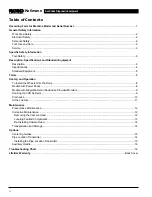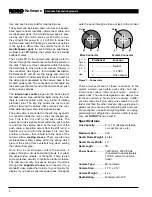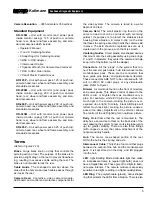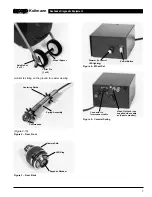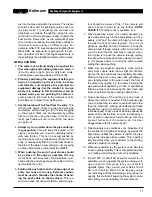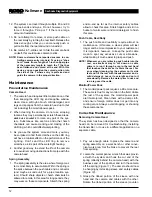
12. The system can travel through multiple 45 and 90
degree bends and wyes. Do not, however, try to
force it through a P-trap or T if there is a large
amount of resistance.
13. Do not attempt to remove or store push cable on
the reel solely by turning the reel itself. Release the
brake enough so that you can manually push or
pull cable from the reel and wind or unwind it.
14. Be careful in T-entries not to fold the camera back
on itself, this could cause camera to stick.
NOTE! Some customers have reported success in con-
trolling camera entry into hard Ts using a “shoe
horn” made from a length of 1-inch copper pipe
of the necessary length to reach the T that has
been flattened and curved at the end. With this
device, you can position the curved portion into
the side of the T where entry is preferred and
guide the camera in the proper direction.
Maintenance
Preventative Maintenance
Camera Head
1. The camera head requires little maintenance, other
than keeping the LED ring and sapphire window
clean. Use a soft nylon brush, mild detergent, and
rags and sponges from the camera head up to (but
not including) the monitor/power pack.
2. When cleaning the camera, do not use scraping
tools as they may permanently scratch these areas.
NEVER USE SOLVENTS
to clean any part of the sys-
tem. Substances like acetone and other harsh
chemicals can cause cracking and crazing of the
LED ring, which could affect waterproofing.
3. As you use the system more and more, you may
be surprised to find that scratches on the LED ring
will have a minimal effect on the performance of the
lighting. Don’t sand the LED ring to remove
scratches, as it is part of the watertight housing.
4. Another good way to extend the life of the camera
is to avoid removing obstructions from pipe with the
camera head.
Spring Assembly
1. The spring assembly is the area where foreign mat-
ter is most likely to accumulate. Within the spring is
the splice between the push cable and a connector
(and maybe a sonde unit for a pipe location sys-
tem). Should sharp objects or harsh chemicals be
allowed to remain in this area for long periods, they
may wear on these components. Stretch the spring
end-to-end as far as the internal safety cables
allow to check this area. Stretch again and stir in a
bucket of warm water and mild detergent to flush
this area.
Push Cable, Reel/Dolly
1. The push cable and reel/dolly require almost no
maintenance. (Of course, a clean system will last
longer and be more impressive to your customers.)
It is important, however, to keep the push cable
clean to spot any excessive cuts or abrasions,
while making it much easier to grasp and push.
NOTE! Whenever you are retrieving push cable into the
reel, an excellent way to cut down on cable
grime is to run it through a rag in the last hand
that touches the cable as it enters the reel. For
an overhaul cleaning, lay the system on its side
feet and fill the reel with lukewarm water and a
mild detergent. Leave it overnight and spin it
occasionally. Remove the water prior to use and
run a rag over the cable.
Monitor/Power Pack
1. The monitor/power pack requires a little more care.
The same is true for any monitor in the field. Unlike
the rest of the system, the monitor/power pack
aren’t waterproof. Clean them with a damp cloth,
and ensure foreign matter does not get into any
cooling vents. Always avoid dropping or shocking
these components.
Corrective Maintenance
Removing Camera Head
The system has been designed so that the camera
head can be removed for troubleshooting, installing
the transmitter, or to use in a different application on a
separate cable.
1. Pay out enough cable to place the camera and
spring assembly on a work bench or other conve-
nient work area. Set the brake to prevent the reel
from spinning.
2. Locate the metal spanner wrench that was provid-
ed with the system and hook the cut end of the
spring (directly behind the camera head) with the
business end of the spanner and turn the camera
off the spring (Figure 11). The camera should now
be hanging by its locking sleeve and safety cables
(Figure 12).
3. Grasp the ribbed portion of the sleeve with one
hand and the camera and cables with the other.
Rotate the ribbed portion of the sleeve (counter-
SeeSnake Diagnostic Equipment
Kollmann
12


